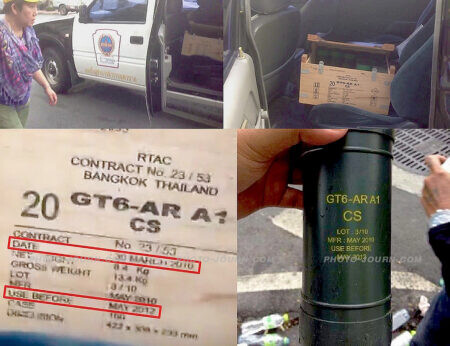A protest rally aimed at toppling the Thailand government led by the neo-fascist Pitak Siam (Protecting Siam) group ended after just eight hours yesterday following a day of intense drama, the use of tear gas by Thailand riot police and the resignation of the group’s head, retired army General Boonlert Kaewprasit.
The anti-government rally saw the government of Prime Minister Yingluck Shinawatra invoke the country’s Internal Security Act (ISA) for parts of Bangkok and surrounding provinces, attracted far less than the one million people expected, but left 61 people injured and 137 arrested.
Despite a doctrine based on the forced removal of the elected government and the installation of a military junta – considerably more right-wing than most other Thailand political groups – yesterday’s rally received wide supported from a number of other opposition groups, including the ultra-royalist People’s Alliance for Democracy (PAD), responsible for the closure of Bangkok’s Suvarnabhumi airport for eight days, in 2008.
Other groups who leant their support to the rally included Thailand’s multi-coloured-shirts, the Peace-Loving Thais group, the Group of People from 16 Southern Provinces, the Dhamma Army, and a collective of state enterprise labour union activists.
It rained tear gas canisters

Disenfranchised farmers from Thailand’s Northeast, the People’s Movement for a Just Society (P-move – who represent landless farmers and displaced people), and the Assembly of the Poor were also said to be participating.
Despite support from many quarters it is estimated that fewer than 20,000 people attended the rally, with an estimated 5,000 of them clashing with riot police who had closed some roads leading to the rally site just prior to 9am.
National police chief Police Major General Adul Saengsingkaew said the protesters who clashed with police were predominantly bedecked in the colours of the yellow-shirt PAD movement and threw teargas canisters and other objects at police, forcing the police to retaliate.
Major General Saengsingkaew said the Thai police use the 555CS Spede-Heat grenade produced by Federal Laboratories of Pennsylvania, but several Chinese-made GT6-ARA1CS with expired use-by dates had been recovered from the scene of the morning clash.
However, a photo and video clip posted to webboard.serithai.net of a crate of 20 of the Chinese-made grenades in the back of a Metropolitan Police Bureau (MPB) pickup truck circulating on the Thai webboard Serithai and others casts doubts on the police claim that the Chinese-made grenades were not used by them.
The photo clearly shows a shipping crate stencilled with a Royal Thai Army Chemical Department (RTAC) contract number, date of order, date of manufacture, and use-by date on rear seat of the police vehicle, and uniformed police nearby.
With the morning clash followed by another early in the afternoon, General Kaewprasit announced at 5.25pm that he was calling the rally off and stepping down as the head of the ultra-right-wing group, claiming “if the rally continues, there is a risk that demonstrators will lose their lives”.
General Kaewprasit said the protest was peaceful, and accused the government of deliberately trying to derail it out of fear, a view supported by some academics who said it was likely Pitak Siam would reemerge in the future with a new leadership.
In the meantime the question of what a crate of Chinese-made teargas canisters supplied under an RTAC contract were doing on the backseat of a MPB truck remains unanswered.
Feature video Kim Birkkjaer Lund
Feature photo STR via The World
Related:
- Thailand Internal Security Act shows rattled Thai Government
- Thaksin royal pardon has Thailand coup watchers on alert as the 9s line up again
He has spent extensive periods of time working in Africa and throughout Southeast Asia, with stints in the Middle East, the USA, and England.
He has covered major world events including Operation Desert Shield/ Storm, the 1991 pillage in Zaire, the 1994 Rwanda genocide, the 1999 East Timor independence unrest, the 2004 Asian tsunami, and the 2009, 2010, and 2014 Bangkok political protests.
In 1995 he was a Walkley Award finalist, the highest awards in Australian journalism, for his coverage of the 1995 Zaire (now Democratic Republic of Congo) Ebola outbreak.
Most recently he was the Thailand editor/ managing editor of AEC News Today . Prior to that he was the deputy editor and Thailand and Greater Mekong Sub-region editor for The Establishment Post, predecessor of Asean Today.
In the mid-80s and early 90s he owned JLF Promotions, the largest above and below the line marketing and PR firm servicing the high-technology industry in Australia. It was sold in 1995.
Opinions and views expressed on this site are those of the author’s only. Read more at About me
Latest posts by John Le Fevre (see all)
- Kaavan’s great escape photo special (video & gallery) – November 30, 2020
- A real life fairy tale: Cambodia provides sanctuary to Kaavan, the world’s loneliest elephant (video & gallery) *updated – November 30, 2020
- Death for corruption and press freedom abused as Thailand continues Nth Korean-like slide – July 23, 2015
- Thailand’s young rice farmers boost income, slash costs with switch to organic, AWD method – May 29, 2015
